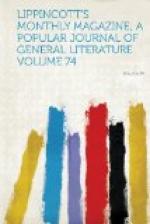give were it of any interest to do so—and
proposed to sell it to him for a large sum. Eventually,
a bargain was struck on this basis: The dealer,
with perfect knowledge of the origin and authorship
of the work, was to pay one thousand francs for the
bust, and to pay the seller another thousand if and
whenever he, the dealer, should succeed in reselling
it for more than a certain price named. Thereupon,
in accordance with the usual practice in such cases,
the bust disappeared from sight. It was stored
in the secret repositories of the antiquario
till the circumstances attending its creation should
be a little forgotten, and dust and dirt should have
corrected the brand-new rawness of its surface, ready
to be produced with much mystery as a recent trouvaille
when a likely purchaser should loom over the Apennine
which encircles “gentile Firenze.”
In due time, one of the largest and brightest of those
comets whose return is so accurately calculated and
eagerly expected by the Florentine dealers in ancient
art made his appearance in the Tuscan sky—no
less than a buyer for the Louvre. Those were the
halcyon days of the Empire, and money was plenty.
Poor Bastianini’s bust was brought out with
all due mystery, duly admired by the infallible French
connoisseur, and eventually purchased by him for the
imperial collection for, I think, five thousand francs—at
all events, for a sum sufficiently large to give the
man who had bought the bust from the poor artist the
right to demand his supplementary payment. He
did so. But the greed of the dealer prevailed
over his prudence, and he refused to give his accomplice
in the fraud the promised share in the plunder.
Of course that ensued which might have been expected.
The defrauded rogue “split.” The
bust sold to the Frenchman was easily identified with
that which Bastianini had made, and which had been
known to all artistic Florence, and the authorities
at the Louvre were duly certified by many a loud-tongued
informer that they had been gulled. The information,
as is usually the case with information of the kind,
came too late to be of service to the buyers, but
not too late to give them serious annoyance.
The bust had been exhibited at the Louvre in a prominent
place; it had excited considerable notice; none of
the savants presiding over that establishment had
conceived the smallest suspicion of its genuineness;
and it was excessively disagreeable to have to admit
that they had all been deceived by a work made the
other day by an unknown Florentine artist. It
was so disagreeable that the gentlemen in question
had not the courage to face the truth. They pooh-poohed
their informants, professed to adhere without a doubt
to their own first opinions, and the bust, to the
great amusement of all the Florentine art-world, remained
in its place of honor at the Louvre, exhibited as a
cinque-cento terra-cotta for a long time after all
Florence was perfectly cognizant of its real history,
and after the young artist had produced three or four




